by Intissare Aamri // Dec. 11, 2020
Culture Device is an artistic venture revolutionizing normative definitions of art and beauty through its projects. One such project, Drag Syndrome, acts as an inclusive performance platform for exceptional artists with learning disabilities. Founded by artistic director Daniel Vais in 2018, Drag Syndrome is the world’s first collective of drag queens and kings with Down Syndrome. The protagonists are bold and unstoppable: on stage they dismantle stereotypes and explore new frontiers with their fierce demeanor and improvisational prowess. During our conversation, Vais unfolded anecdotes about the group, discussing how they deal with criticism and ableism in mainstream culture and their latest collaboration with o2 Music Deutschland.
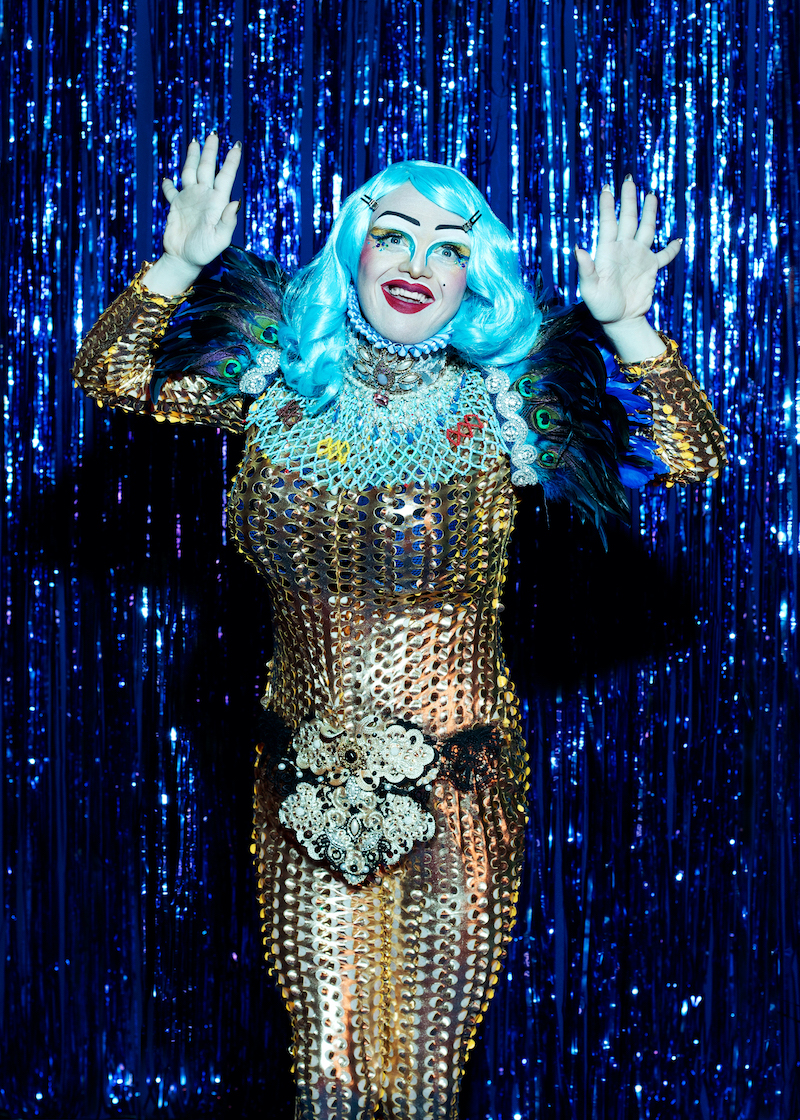
Drag Syndrome: ‘Instagram for Business,’ 2020 // Photo by Scallywag Fox, courtesy of o2 Music Deutschland
Intissare Aamri: As choreographer and artistic director of Culture Device for the last decade, you have been successfully producing social-cultural events across the UK and overseas, starring professional performers with Down Syndrome. How did the decision to found Drag Syndrome in 2018 come about?
Daniel Vais: It was a magical moment and it all started by chance. Sometimes you have to enable inspiration to reach you without chasing it, it’s essential to follow your inner senses and you will certainly discover something revolutionary. One of the artists from Culture Device came to a venue while drag queens were performing and they said, “Wow, I want to try that too.” In the company, all the members have versatile talents, from dancing to acting to modeling. Therefore, their desire didn’t come as surprise: drag performance was and is just another layer for them to experience.
I responded to the appeal by affirming that a dress and a wig are insufficient and, like any other art form, it has to be taken seriously. That’s when I advised them to conduct extensive research. People with learning disabilities are blessed by excellent knowledge and involvement with contemporary culture, and sometimes the public is not aware of it. They have grown up spending numerous hours watching films, reading magazines, listening to music; they have an inconceivable memory and contemplation skills. Therefore, I trusted their aspiration for doing drag. During a break, I said, “We should call it Drag Syndrome,” and they all laughed so animatedly. It all started out as an experiment—out of sincere curiosity to expand the artistic realms of the artists—and that’s when the collective was conceived.
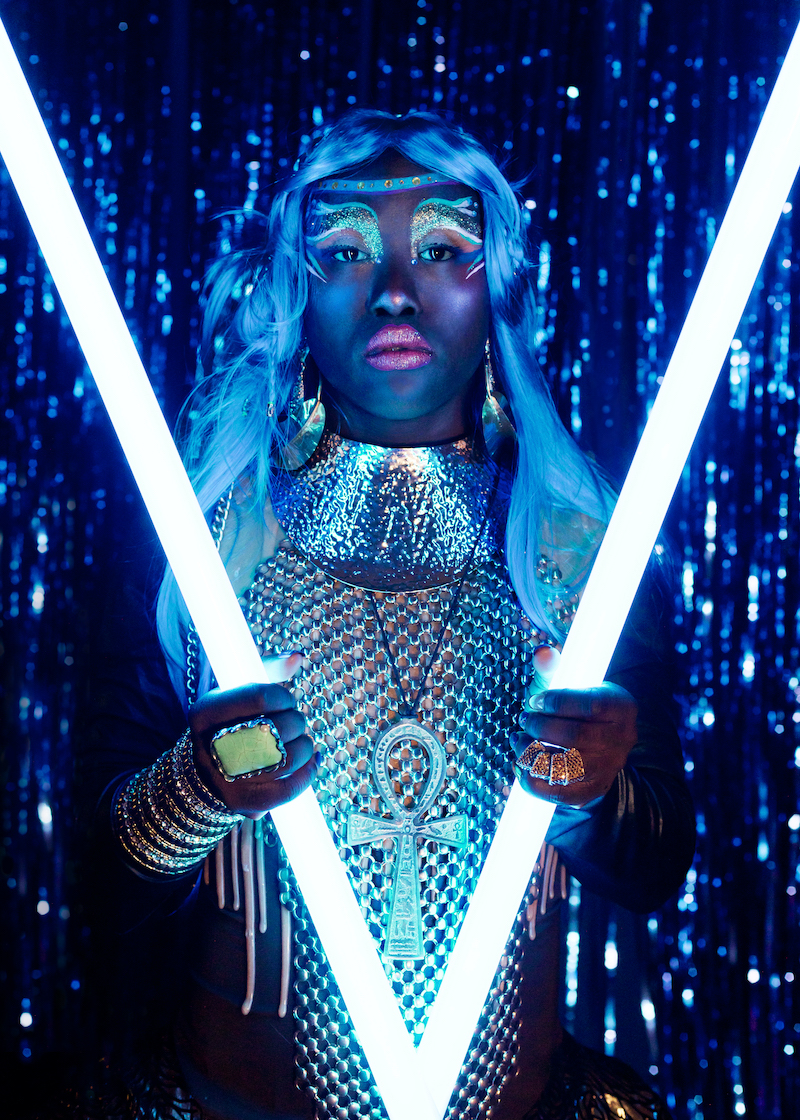
Drag Syndrome: ‘Instagram for Business,’ 2020 // Photo by Scallywag Fox, courtesy of o2 Music Deutschland
IA: Drag is about transformation, the stage allows kings and queens to explore and challenge gender norms and sexual equality, yet the starting point is art and freedom rather than the disability. Now, after sold-out venues and mainstream success, how has the artistic process changed in the making of the shows and the relationship with the audience?
DV: Mainstream success comes with a magnifying glass. When we started to naturally step away from the avant-garde and underground scene, we realized that we had to tone down the truth. Being invited to bigger festivals, made by international and larger crowds made up of different mentalities, meant more criticism. Most queens and kings are fierce: they push boundaries, they have a sarcastic sense of humor, they are extremely edgy and sexual when in character. Subsequently, festival producers began to censor these acts and try to control their choreographies.
This was when I discerned that art is tainted. It’s not art anymore, just entertainment. People pay to feel good and to forget about the world, but, honey, if you ask for drag you can’t really ask for goody-two-shoes. Artists with learning disabilities do what they feel like doing despite forced directions, and their instinct always wins.
Regarding costumes, we have a style called “anything goes.” Sometimes it’s pristine—the makeup expertise will be superb—and sometimes it’s just about blasting color into the face. That’s the way we roll. Regarding the performances, as a choreographer, I am specialized in improvisation and, in my career, I never gave any step to my artists. I trust them 111%: they mostly perform under a track that they didn’t know before. We just talk about the concept, the essence of it and we simply execute it.
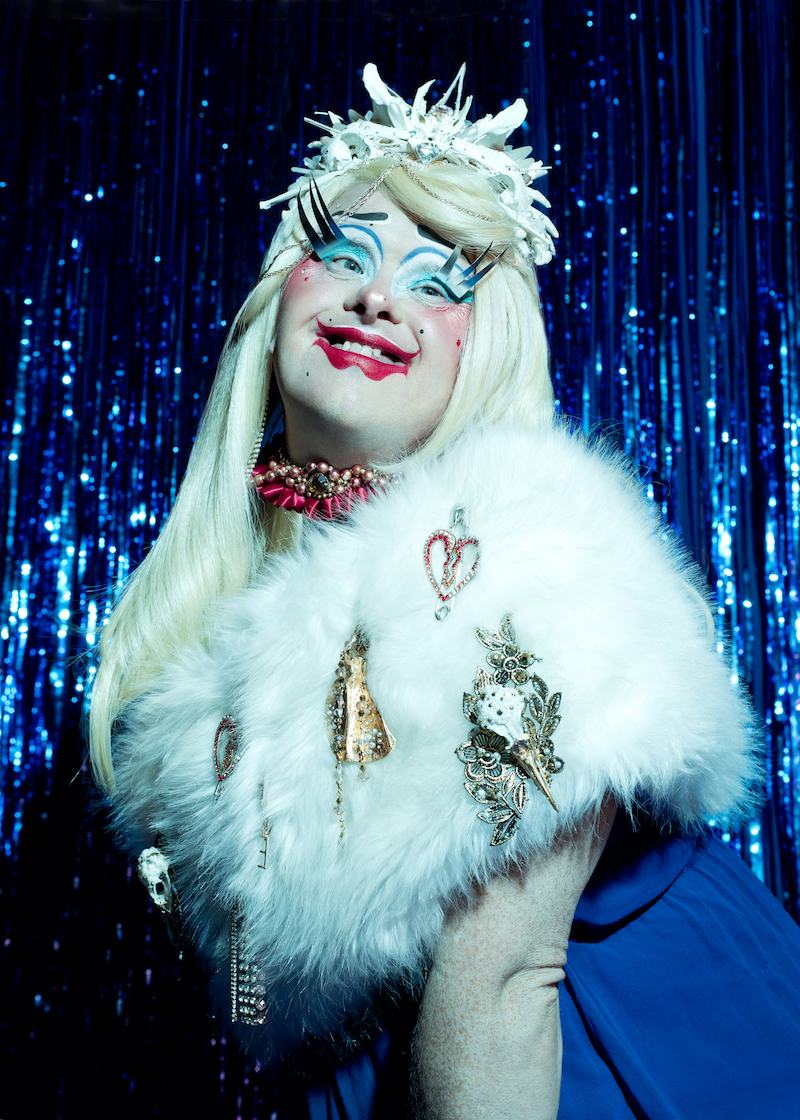
Drag Syndrome: ‘Instagram for Business,’ 2020 // Photo by Scallywag Fox, courtesy of o2 Music Deutschland
IA: Drag Syndrome is blurring boundaries by asserting its performers’ freedom of expression in terms of their sexuality, yet many adults with DS are under guardianship, which can drastically affect their legal rights and decisions, from romantic relationships to voting. How do you see Drag Syndrome as an outlet for these individuals?
DV: You touched on a very delicate subject. I remember that one day I received a message from a fan who always wanted to do drag, and I decided to invite him to join us. Unexpectedly, his family didn’t allow him to. I see, indeed, all the unpleasant aspects of the structure that surrounds individuals with DS, but at that moment I realized that it was not my place to intervene. I can’t judge their choices. I needed to create big boundaries, as I am not a social worker. If the situation won’t admit them, unfortunately, it is beyond my power, despite being very painful. How many talented souls are out there? There are many stars to discover. We definitely initiated the conversation about sexuality and disabilities but we are not compelled to drive it. I can offer a platform and inclusivity, but you need to fight for it and follow your passion. I always suggest to research and get in contact with choreographers, people that have more experience, to find a way. You need to be independent, resourceful and creative. You just have to do it!
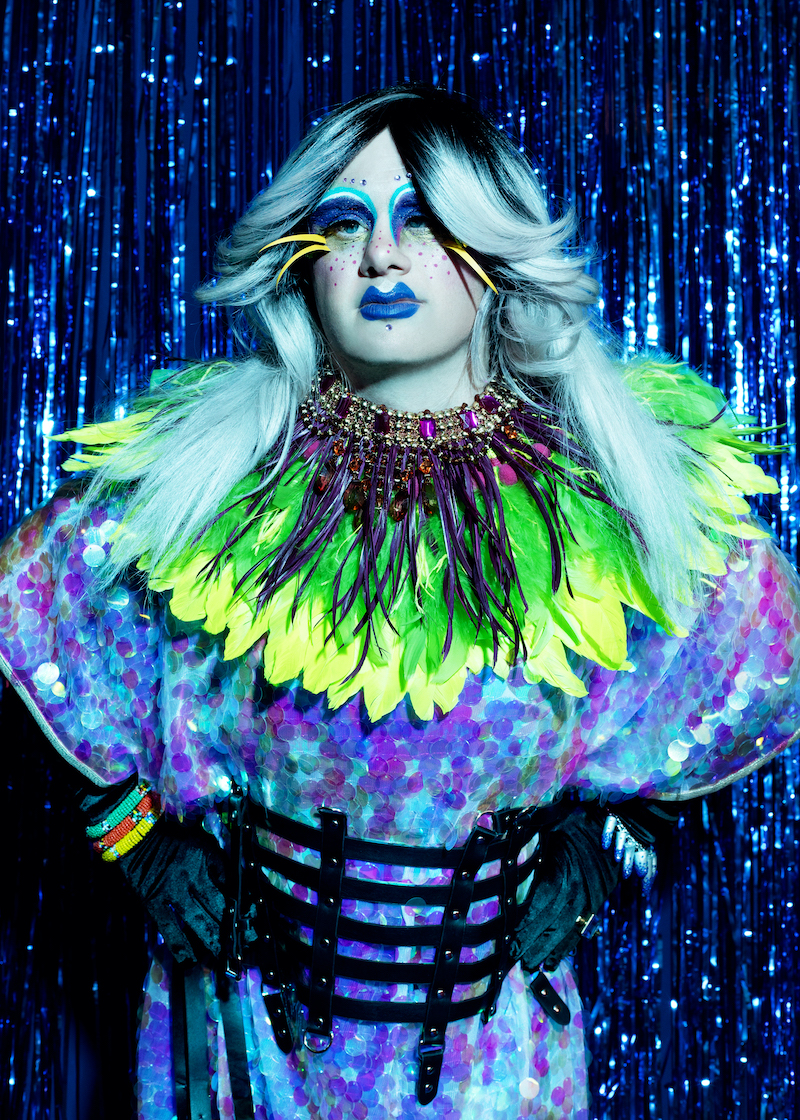
Drag Syndrome: ‘Instagram for Business,’ 2020 // Photo by Scallywag Fox, courtesy of o2 Music Deutschland
IA: Lack of accessibility and diversity in art spaces and institutions is still a pressing issue. What do you think should be done to create a more inclusive scene for artists with learning disabilities?
DV: Only curiosity will change it. That’s it. Curiosity makes you explore divergent paths, makes you excited and provides you the power to act. I tried to present artists with learning disabilities in every art establishment, but they were not always welcome. If art institutions are not curious, if they don’t want to evolve and include important topics, like learning disabilities, then it is a reflection of their ableism and detachment from contemporary culture. Most museums or entrenched art spaces are presenting disability dialogues in a hidden headline, invariably offering a small space in the corner.
We are not part of the establishment but we are influencing it from the outside. We are changing the game because we don’t play politics. I remember that when we started nobody wanted to book us. Dame Judi Dench, the actress, came to an event where we performed and I asked her for advice: “What shall I do to make it work?” She just responded, “If it’s good, it will happen.” I was in a rush, I wanted it to happen, but I knew she was right; I had to trust our process.
The reason why we are very ambitious is a very gentle reason, which is time. The health of people with learning disabilities can deteriorate early. It’s a fact that is hard for me to grasp. We don’t have time for society to catch up. We have to have our own rhythm. People are not aware of this matter and it is a very important subject. Compliments and appreciation are great, but action needs to happen fast.
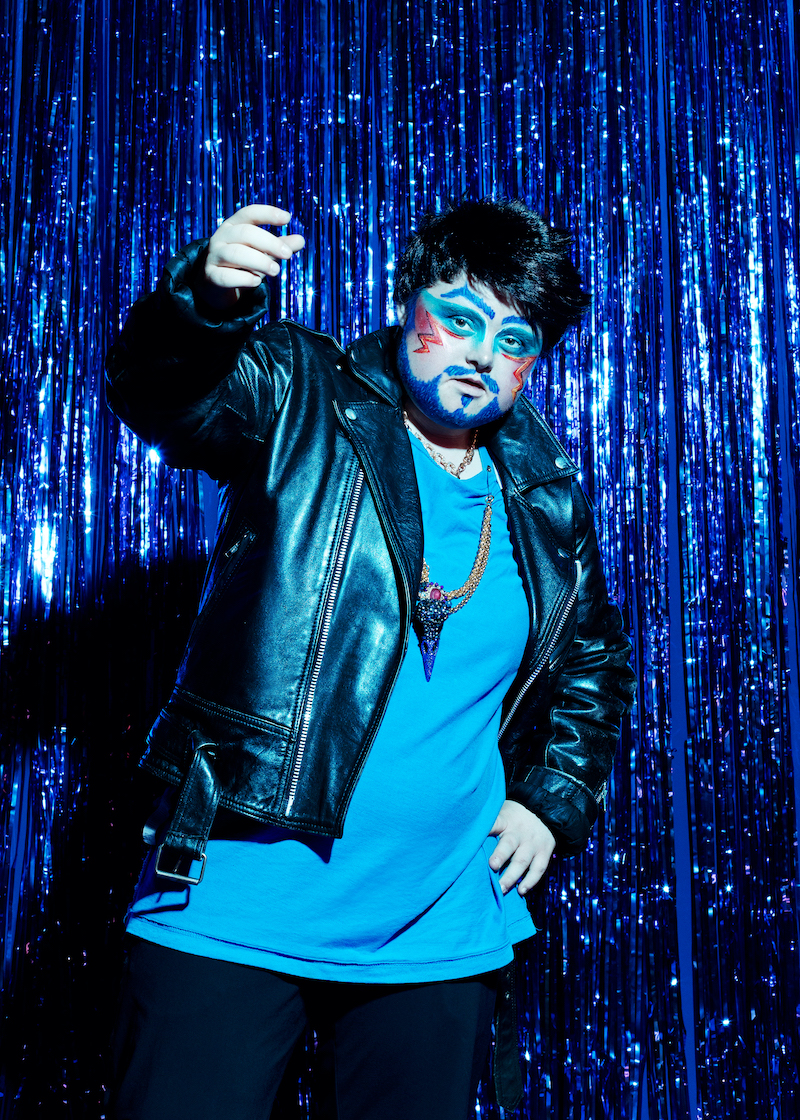
Drag Syndrome: ‘Instagram for Business,’ 2020 // Photo by Scallywag Fox, Courtesy of o2 Music Deutschland
IA: Drag comes in every shape and skin color with no form of discrimination and you have created an audacious platform for talented artists with DS. How can these opportunities be created in countries where cultural and social limitations are present and how do you respond to negative comments?
DV: I think the process has to happen naturally, as long as you remain determined. I can give guidance but uniqueness is essential and it takes time and perseverance. It’s art. If you have it, just do it. I always prepared my artists for possible backlashes, telling them to just do what they love. When you are out there, people suddenly have opinions or criticisms and they want to control you. But as long as you enjoy your art, do it and nothing else will matter.
Cultural limitations are omnipresent around the world and although numerous countries are censoring and judging, you can still decide do it underground. Where gender and diversity are not celebrated, drag finds a way through its fluidity and it can open many conversations. What you decide to listen to is your choice. For example, on social media, we don’t respond to hate. This makes us stronger. It’s extremely painful to receive heinous comments. It’s hard, and people with learning disabilities receive that on a daily basis. It takes a big personality, like Justin Bond, to be able to brush it off.
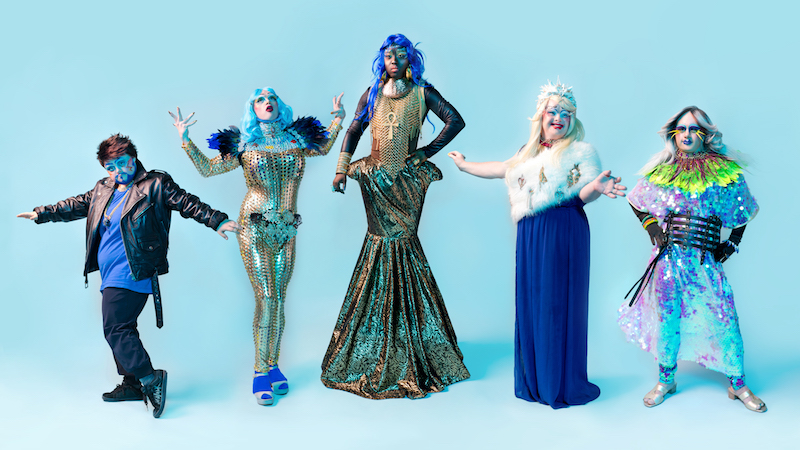
Drag Syndrome: ‘Instagram for Business,’ 2020 // Photo by Scallywag Fox, courtesy of o2 Music Deutschland
IA: Can you speak about one of the performances that made an impact on you?
DV: There are many beautiful memories. I remember our debut performance. We got ready in my studio and excitement was in the air. We arrived at the venue and I saw a drag queen heading in my direction. I guessed other drags were performing in the same location, but it was indeed one of my artists, Horrora Shebang. That was undoubtedly the power of transformation. My heart skipped a beat. I asked her to open the show: she grabbed the microphone and said, “Good evening bitches,” and the crowd applauded in amazement.
Another distinctive episode that comes to mind is when we performed at RuPaul’s DragCon. On that occasion, we felt deeply respected. We were walking around the venue, all the notorious queens were curious to take pictures and compliment the artists. We felt acknowledged as a collective, surrounded by an international drag community. When one of my artists hit the stage, people were cheering with enthusiasm—the producer was certain it was RuPaul who had come out. Davina came to me, emotional, and said, “This is all I wanted to do! It was a dream and now it’s reality.” We knew that day that things had changed forever.
IA: Drag Syndrome is constantly evolving. What plans are on the horizon and can you tell us more about the collaboration with o2 Music Deutschland?
DV: A week before the pandemic, we were supposed to kick off a world tour with 35 confirmed dates. It was definitely a sad circumstance when the physical tour was canceled, but we didn’t give up. We started to focus instead on online shows and we are currently exploring numerous ideas and territories. We don’t know what will happen next year but we are adaptable: we have a book club, digital events and we will be soon recording an EP.
My artists have big inspirations and aspirations; they have plans for their careers and they are making them happen. Germany was particularly welcoming towards my career and projects—it was the first place that booked me. It is quite a leading country in the European art scene and German crowds are curious and open-minded, which is quite different from London, where you need to be established in order to be offered a chance. So I wasn’t surprised when o2 Music Deutschland invited us to collaborate on the ‘Instagram for Business’ campaign. ‘Instagram for Business’ is sharing platforms, talents and news, allowing my artists to gain empowerment, to be recognized by a broader community. The shoot was marvelous. Scallywag Fox photographed the collective, while Marc Meier did the video, highlighting their creativity. The images came out beautifully. This collaboration is a real reflection of where we’re at.
This article is part of our feature topic of ‘Accessibility.’ To read more from this topic, click here.






















